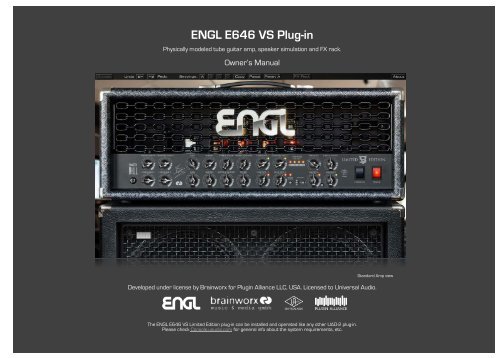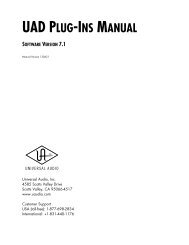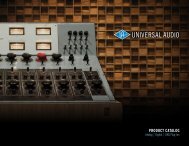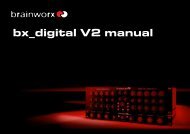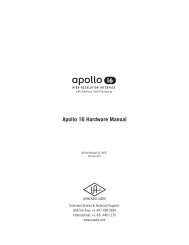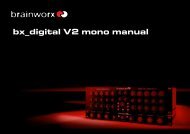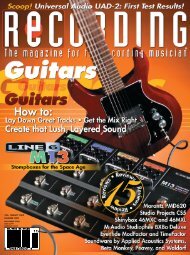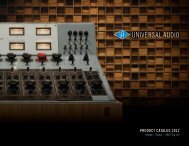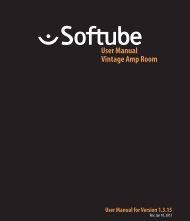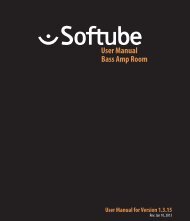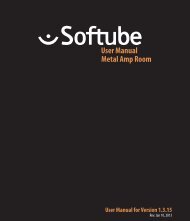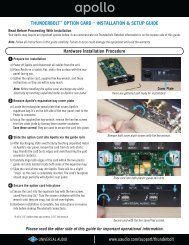ENGL E646 VS Plug-In Manual - Universal Audio
ENGL E646 VS Plug-In Manual - Universal Audio
ENGL E646 VS Plug-In Manual - Universal Audio
You also want an ePaper? Increase the reach of your titles
YUMPU automatically turns print PDFs into web optimized ePapers that Google loves.
<strong>ENGL</strong> <strong>E646</strong> <strong>VS</strong> <strong>Plug</strong>-in<br />
Physically modeled tube guitar amp, speaker simulation and FX rack.<br />
Owner’s <strong>Manual</strong><br />
Standard Amp view<br />
Developed under license by Brainworx for <strong>Plug</strong>in Alliance LLC, USA. Licensed to <strong>Universal</strong> <strong>Audio</strong>.<br />
The <strong>ENGL</strong> <strong>E646</strong> <strong>VS</strong> Limited Edition plug-in can be installed and operated like any other UAD-2 plug-in.<br />
Please check Console.uaudio.com for general info about the system requirements, etc.
<strong>ENGL</strong> <strong>E646</strong> <strong>VS</strong> Limited Edition <strong>Plug</strong>-in<br />
Physically modeled tube guitar amp, speaker simulation and FX rack.<br />
<strong>In</strong>troduction<br />
The <strong>ENGL</strong> <strong>E646</strong> <strong>VS</strong> plug-in is the next level in guitar processing. It offers a faithful digital recreation<br />
of the original tube amp circuit and adds several important tools to help guitarists in<br />
multiple situations. <strong>In</strong> the studio, on stage or in the rehearsal room.<br />
<strong>In</strong> the FX Rack view you can access a noise gate, a vintage delay, 64 world-class Recording<br />
Chains and a power amp simulation including an on-board power soak.<br />
FX Rack / Zoom view<br />
All of these features can be used or bypassed individually. You can - for example - bypass<br />
the Preamp of the plug-in and record your own original tube preamp using the plug-in’s<br />
power amp simulation, recording chains and FX!<br />
Just connect the uncompensated Preamp output to the line-in of your audio interface<br />
and record super-authentic guitar tones. This is not your average amp sim.<br />
The main applications for this plug-in are:<br />
1. Recording DI guitars, then editing and processing them in<br />
the DAW completely, using the internal amp simulation,<br />
the recording chains and the FX Rack.<br />
2. Recording hardware preamps through the power amp<br />
simulation and Recording Chains.<br />
3. Practicing at home with minimal latency (in Apollo´s Console,<br />
for example), via your studio speakers, a home stereo<br />
system, headphones or a real guitar amp and cabinet.<br />
4. Playing live via a real power amp and speaker setup.<br />
5. Playing LIVE, plugged straight into a live Console and /<br />
or an in-ear system.<br />
6. Re-Amp less than perfect DI guitar tracks, previously<br />
recorded with other guitar-amp simulations.
The Basics<br />
You can use the amp section of this plug-in exactly like you would operate the real <strong>ENGL</strong> <strong>E646</strong> <strong>VS</strong> tube amplifier.<br />
<strong>Plug</strong> in your guitar (via your computer audio interface in this case), select a Channel, adjust Gain, Tone and Volume... and Rock’n’Roll !<br />
The <strong>ENGL</strong> plug-ins were developed with the Apollo series interfaces in mind really. Of course the <strong>ENGL</strong> plug-ins will work with any UAD-2 device, but to experience the ultra-low latency<br />
(desirable for playing in real-time) you need an Apollo interface.<br />
A good producer’s trick is to use a REAL GUITAR AMP (a small combo, for example) for real-time monitoring in the control room during tracking while recording only the DI guitar<br />
signal! Then use the <strong>ENGL</strong> guitar amp plug-in when you play back the recorded tracks together with the rest of your music. You will need to split the dry guitar signal so it can be<br />
recorded in the computer and routed to the real guitar amplifier input at the same time.<br />
To play and record dry DI guitar tracks with the lowest latency and the highest quality possible connect your guitar to the Hi-Z <strong>In</strong>put of the Apollo <strong>In</strong>terface or connect a quality DI<br />
Box and Mic Preamp to a line input of your Apollo series interface.<br />
The <strong>In</strong>sert Effects Switch in the Console Software:<br />
If you insert the <strong>ENGL</strong> <strong>E646</strong> <strong>VS</strong> plug-in in the Console software mixer (to use the plug-in with the shortest possible latency) you have to decide whether you want to record processed<br />
guitar amp sounds (switch INSERT EFFECTS to REC) or whether you only want to record the dry DI guitar signal, while monitoring the processed amp sound during tracking,<br />
of course (switch INSERT EFFECTS to MON).<br />
The advantage of only monitoring the processed sound is that you can alter the settings of your amp and FX completely during mixdown! If you find out later that less or more<br />
Gain or Delay would sound better for your song you can still make that happen.<br />
The advantage of recording pre-processed guitar tracks might be that you will need less plug-ins during mixdown, as your guitar tracks will be ready to be mixed. All you can do<br />
then is EQ and compress the recorded guitar tracks, or add effects, just like you would with traditional guitar amp recordings. Once you know ‘your sound’ you may even save<br />
some time by recording processed guitar tracks and using them without further tweaking or fiddling around... your band mates or your producer may even appreciate this. ;-)
The controls of the <strong>ENGL</strong> Amplifier section<br />
CHANNEL SELECT 1-4(via up/down & left/right arrows or Channel Select switches)<br />
The <strong>E646</strong> <strong>VS</strong> amp has four channels. To switch between the upper row of channels<br />
(1&2) and the lower row (3&4) you may use the arrows just like with the hardware<br />
amp. Alternatively you can use the CHANNEL SELECT LEDs and access each channel<br />
directly.<br />
GAINS 1-4 (adjustable per channel):<br />
Dial in as much crunch and distortion as you like with the gain knobs. Each of the<br />
channels has its own dedicated Gain control. Channel 1 is the ‘CLEAN’ channel,<br />
Channel 2 is the ‘CRUNCH’ channel. Channels 3 & 4 are both ‘LEAD’ channels.<br />
Tone Stack (BASS, MIDDLE, TREBLE, adjustable per channel):<br />
Just like any guitar amp the <strong>ENGL</strong> amps have controls to make the guitar tones<br />
sound more mellow or harsher, add or cut low end, and boost or cut mids. There<br />
are definitely no rules when it comes to adjusting the Tone Stack controls. If it<br />
sounds right it probably IS right... You may browse through our presets and listen to<br />
a wide range of different settings, many of which are customized for commonly used<br />
guitars like Teles, Strats or Paulas...<br />
MIDDLE VOICED (channels 3 & 4 only):<br />
The channels 3 & 4 offer two different mid controls. You may switch between the<br />
two sound options and use them for riffs or solo sounds to your liking.<br />
TREBLE x2 (channels 1 & 2 only):<br />
The channels 1 & 2 offer a dedicated TREBLE control for each channel. This way you<br />
can easily adjust the sound according to the guitar and / or pickup you use for clean<br />
or crunchy sounds.<br />
MASTER A & B<br />
The original hardware <strong>E646</strong> amp has two MASTER channels so you can play with<br />
different overall volume. We have modeled both channels so you can automate<br />
rhythm and lead volumes, for example. Switch between both channels by clicking<br />
the little switch between the MASTER A & B knobs alternating.<br />
PRESENCE<br />
With the PRESENCE control you add or cut ultra-high frequencies. Make your<br />
sound harsher or duller to your liking. The PRESENCE control affects all four channels<br />
of the amp. You may use the A/B/C/D setting switches in the toolbar to recall<br />
different settings on the fly.<br />
DEPTH PUNCH<br />
Add some serious low-end to your sound. Some of the Recording Chains contain<br />
less bass and may be enhanced in the low end by cranking up the DEPTH PUNCH<br />
more than with other Recording Chains. The DEPTH PUNCH control affects all four<br />
channels of the <strong>E646</strong> because it sits in the power amp. You may use the<br />
A/B/C/D setting switches in the toolbar to recall different settings on the fly.<br />
STANDBY and POWER<br />
You may bypass all processing of the plug-in with these two switches. Contrary to<br />
the real amp in the plug-in these two switches are linked. No need to warm up<br />
tubes in the plug-in or protect speaker cabinets.<br />
If you only want to bypass the Amp section of the plug-in (to record your own hardware<br />
tube preamp, for example) please use the FX Rack / Zoom view. You will find<br />
the needed controls in the Power Soak section. Details below.
The controls of the <strong>ENGL</strong> FX Rack<br />
1. NOISE GATE<br />
‘CLOSED’ LED<br />
When lit this LED indicates that the Noise Gate is CLOSED. This means the<br />
THRESHOLD setting is higher than the incoming guitar signal and the noise gate<br />
dims the output signal of the amplifier by the amount adjusted with the RANGE control<br />
(e.g. 15dB in the picture above).<br />
NOISE GATE ON / OFF:<br />
Enable or disable the Noise Gate completely. Switch up (‘on’) means the Noise Gate<br />
is activated.<br />
THRESHOLD:<br />
The Noise Gate will dim the output signal of the amplifier as soon as the input signal<br />
(your guitar signal) falls below a certain level. This level is called Threshold. Adjust<br />
the Threshold so the noise of the overdriven amp will be reduced, but make sure you<br />
don´t cut fading notes or chords.<br />
RANGE:<br />
The output level of your amplifier will be reduced or muted when the input signal is<br />
lower than the Threshold setting. You may dim the output level only by a few decibels<br />
(dB), or completely mute the output in pauses by setting the RANGE to its maximum.<br />
2. AMP FILTERS (switchable pre / post)<br />
TIGHT Filter:<br />
With the TIGHT filter you can cut LOW frequencies of either the DI guitar signal<br />
(PRE) or the processed amp output (POST).<br />
PRE: If your guitar pickups produce a rumbling bass sound you can filter the low<br />
end before the DI sound even hits the amplifier.<br />
POST: If you want to cut some of the low end of your amplifier setting (maybe even<br />
only temporary) you can use this studio quality high pass filter to reduce the bass.<br />
OFF: when set to OFF the TIGHT filter is in bypass mode.<br />
SMOOTH Filter<br />
With the SMOOTH filter you can cut HIGH frequencies of either the DI guitar signal<br />
(PRE) or the processed amp output (POST).<br />
PRE: If your guitar pickups catch a lot of hiss or noise you can filter the high end before<br />
the DI sound even hits the amplifier.<br />
POST: If you want to cut some of the high end of your amplifier setting (maybe even<br />
only temporary) you can use this studio quality low pass filter to reduce treble.<br />
OFF: when set to OFF the SMOOTH filter is in bypass mode.
The controls of the <strong>ENGL</strong> FX Rack<br />
3. RECORDING CHAINS (Speaker Selection)<br />
REC CHAINS:<br />
Simply select a speaker and a complete studio setup by browsing through the REC<br />
CHAINS pull-down menu!<br />
<strong>In</strong> the past two decades Brainworx owner Dirk Ulrich has produced and recorded<br />
with members of DREAM THEATER, TOTO, MICHAEL JACKSON, and with many<br />
more famous and infamous acts. The Brainworx Studio in Germany (www.brainworxstudio.de)<br />
is equipped with one of only nine NEVE VXS 72 Consoles ever made, and it<br />
also hosts some of the finest outboard EQs and mic pre-amps available.<br />
Using this impressive setup Dirk has produced a huge variety of customized ‘Recording<br />
Chains’ for the <strong>ENGL</strong> amplifiers, which you can apply to your plug-in amp settings.<br />
Imagine a selection of 64 perfectly miked and EQ-ed guitar cabinets which you<br />
can select and use instantly with a single mouse click!<br />
Many amp simulations give you some captured impulses of a selection of cabinets<br />
and microphones, then they leave it up to you to EQ and further process these incomplete<br />
setups. Mixing different microphone setups, adjusting phase and EQ, and<br />
so on. But this really is not an easy job, it takes years of experience to get it right.<br />
Now all you have to do is select the Recording Chain which sounds best for your<br />
amp channel and setting, adjust the Tone Stack and Gain and you´re good to go!<br />
Recallable, reliable, flexible and fast.<br />
+ / - Switches (Plus / Minus):<br />
Browse through the REC CHAINS by either using the pull-down menu of the REC<br />
CHAIN text box (see above) or just click through the settings using the + and - symbols.<br />
AUTO & BAR selection:<br />
If you are trying to find the best sounding REC CHAIN for your actual song it can be<br />
tiring having to play a few chords, then grabbing the mouse to select the next REC<br />
CHAIN, playing a few notes again, grabbing the mouse again, etc.<br />
<strong>In</strong>stead the <strong>ENGL</strong> amp plug-in offers you the AUTO mode:<br />
Just select a pattern (1 Bar, 2 Bars or 4 Bars) and the plug-in will activate the<br />
available REC CHAINS automation, following the actual tempo setting of your DAW.<br />
You can now play uninterrupted and simply listen to the sound of the various REC<br />
CHAINS as the plug-in switches through all of them every single bar, every two bars<br />
or every four bars, depending on your setting.<br />
As soon as you hear the speaker setup you like best just stop AUTO mode by clicking<br />
the AUTO button again and manually select the desired REC CHAIN. Afterwards<br />
just fine-tweak the TONE STACK and GAIN and there you are.<br />
And if for any reason you should not like any of the Recording Chains the plug-in offers<br />
you may use the very last setting (labeled CABINET BYPASS) and use your own<br />
miked cabinet. This setting will give you the sound of a tube guitar amp wired<br />
straight into a Console, which also may be a nice effects sound.
The controls of the <strong>ENGL</strong> FX Rack<br />
4. LO-FI DELAY<br />
We have modeled a vintage stomp box delay and modeled the typical sound of it.<br />
Limited frequency bandwidth, fading high frequencies on repeats, etc. Then we added<br />
modern features like a mix control, DAW controlled bpm-based tempo sync, etc.<br />
Of course you will use your favorite selection of external effects like Chorus, Flanger,<br />
Reverb and even other Delays to achieve your signature guitar tone, but we feel that<br />
a nice & easy delay comes in handy even if you only want to try out presets etc.<br />
Testing a lead / solo sound without hearing at least a touch of delay wouldn´t sound<br />
realistic for many players, so we added this one effect. Plus, we really like the sound<br />
of this vintage delay lay lay lay la la l.....<br />
DELAY on/off:<br />
Activate or deactivate the delay and all of its parameters with this switch.<br />
Switch up: Delay is activated.<br />
Switch down: Delay is bypassed / off.<br />
TAP:<br />
You can adjust the delay time by clicking rhythmically on the TAP button with your<br />
mouse. This way you can adjust the tempo of your delay to your guitar riffs even if<br />
you don´t play with a DAW and bpm-based tempo or click track.<br />
TIME:<br />
Alternatively you may just dial in a delay time based on milliseconds using the TIME<br />
knob. Maximum Delay Time: 1,000 ms.<br />
X2 & /2 (adjusting the delay time):<br />
You may switch the actual delay time to double speed by clicking the /2 button.<br />
You may switch the actual delay time to half time by clicking the x2 button.<br />
Both buttons can be pressed repeatedly as long as the maximum delay time of<br />
1,000 ms is not exceeded.<br />
HOST BPM:<br />
This LED panel indicates the actual tempo (4/4 th , based on bpm, beats-per-minute)<br />
reported by the DAW host software<br />
MIX:<br />
Use the MIX control to blend in as much delay signal with the dry amplifier sound<br />
as desired. For unobtrusive delays we recommend settings around 10%, heavier<br />
effect sounds may require settings of 50% or more.<br />
FEEDBACK:<br />
The FEEDBACK controls the number of repeats. While a setting of 99% will result<br />
in an almost infinite delay loop, a typical setting for a rock lead sound may be<br />
around 25%.<br />
LO-FI:<br />
With the LO-FI knob you control the amount of internal distortion, the resampling<br />
quality, etc. The higher you go the worse the quality gets from a pure technical<br />
stand point... but the more interesting it may sound for many guitar sounds and<br />
styles.
The controls of the <strong>ENGL</strong> FX Rack<br />
5. INPUT GAIN:<br />
If you want to drive the input of the <strong>ENGL</strong> preamp harder or softer you may adjust<br />
the input gain to your liking. Some single coil pickups from older or vintage guitars<br />
may deliver low level output which can be compensated with the INPUT GAIN.<br />
The opposite goes for a lot of heavy metal style humbuckers. If you have recorded<br />
the DI signal too hot or if you are using other plug-ins before entering the <strong>ENGL</strong> amp<br />
plug-in you may want to dim the input signal.<br />
With most standard guitars you can and should leave the INPUT GAIN at 0 (zero)<br />
though.<br />
7. PRE-AMP and POWER AMP Activation:<br />
BYPASS PRE:<br />
With the BYPASS PRE switch you can switch off the <strong>ENGL</strong> preamp completely,<br />
which may be wanted if you record your own hardware (tube or solid state) guitar<br />
preamp with the <strong>ENGL</strong> amp plug-in.<br />
<strong>In</strong> this case you may still use the internal POWER AMP and speaker / REC CHAINS<br />
simulation and will be able to achieve amazing results recording your guitar sounds<br />
without using an external power amp and speaker.<br />
Switch up: Preamp is bypassed (off), Switch down: Preamp is active (on).<br />
6. <strong>In</strong>ternal POWER SOAK:<br />
<strong>In</strong> the real world power soaks are being used to reduce the volume of a guitar power<br />
amp. This way you can crank up a (tube) guitar power amp to drive it until it<br />
starts clipping, and still record at a volume which will protect your hearing and keep<br />
the neighbors friendly.<br />
A clipping tube power amp adds distortion and harmonics to the guitar amp signal<br />
and is something most guitar players love. A fully cranked up tube guitar amp tamed<br />
in volume with a power soak will sound different than the same amp with the master<br />
volume turned down.<br />
BYPASS POWER AMP:<br />
If you want to use only the distortion of the <strong>ENGL</strong> preamp you may switch the power<br />
amp simulation off. This may sound cool if you use the <strong>ENGL</strong> plug-in to distort<br />
other signals than a guitar. For a realistic guitar recording we recommend leaving<br />
the power amp on, as it is an integral part of the overall sound of the amp.<br />
We have modeled the behavior of the <strong>ENGL</strong> tube power amp, so you may experiment<br />
with different settings of the Master Volume of the amp and the internal<br />
POWER SOAK. We recommend a setting of roughly -10dB for most scenarios.
The controls of the <strong>ENGL</strong> FX Rack<br />
8. SETTINGS / Top Toolbar:<br />
UNDO / REDO:<br />
You can undo and redo changes you made to the controls of the <strong>ENGL</strong> plug-in at any<br />
time. The undo / redo will work for as many as 32 steps. This makes experimenting<br />
and tweaking knobs easy. If you don´t like what you did... just undo it.<br />
SETTINGS (A/B/C/D):<br />
The <strong>ENGL</strong> amp plug-in offers four internal settings (A/B/C/D) which will be stored<br />
with every preset. So, one preset can contain up to four amp and effects settings.<br />
You may use similar amp settings with more or less delay, different delay times, etc.,<br />
to quickly switch between different sounds, or you can switch from clean to crunch<br />
to lead within one setup / preset.<br />
The settings can be automated (!) in most DAW hosts. This way it´s possible to<br />
switch from a dry rhythm sound to a lead sound with tons of delay, for example.<br />
COPY / PASTE:<br />
To set up variations of similar sounds you don´t have to dial in all the parameters<br />
several times. Let´s say you like your setting A and want to use the same sound,<br />
just without delay, as SETTING B.<br />
- Simply press COPY while you are in SETTING A.<br />
- Switch to SETTING B by pressing ‘B’ in the SETTINGS section.<br />
- Press PASTE, now SETTING B is identical to SETTING A.<br />
- Bypass the DELAY. Done.<br />
Now you can switch between A & B and play the same sound with or without delay.<br />
FX Rack:<br />
Toggle between standard and zoom view.<br />
FACTORY PRESETS<br />
We have made a lot of presets for the <strong>ENGL</strong> amp plug-in, many of them have been<br />
made to work perfectly with classic guitars like Strats, Teles or Paulas. All of the<br />
factory presets offer A/B/C/D variations, do try them out!<br />
This effectively quadruples the factory sounds you can browse through, and many<br />
similar amp settings sound quite different with different FILTER or DELAY settings.<br />
These presets are only intended to give you an easy start and to demo some of the<br />
tones you can get out of the <strong>ENGL</strong> amp plug-in.<br />
CREATING YOUR OWN SOUNDS & PRESETS<br />
When you start to create your own sounds the most important elements to adjust<br />
are the TONE STACK and the REC CHAINS.<br />
- Select the amp channel you wish to play (clean or lead, for example)<br />
- Set all the controls of the TONE STACK (Bass, Mids, Treble) to the center position<br />
(’12-o-clock’).<br />
- Dial in as much GAIN or Distortion as you like.<br />
- Play through as many REC CHAINS as you like and pick the one that sounds<br />
closest to what you are looking for without altering the TONE STACK.<br />
- NOW start tweaking the TONE STACK to fine tune your amp settings.<br />
- Add Delay or activate filters, the noise gate, etc.<br />
Experiment, be creative. We are confident that the different channels of the amp<br />
and the huge selection of REC CHAINS will offer you many possible combinations<br />
that will sound great on a big variety of musical styles and genres.<br />
Combine the <strong>ENGL</strong> amps with other UAD-2 plug-ins (dynamics, effects, room simulation),<br />
and you will be able to create countless world-class production-ready guitar<br />
sounds in the box. Enjoy.


